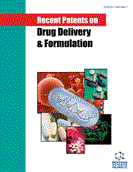Abstract
Nanotechnology is one of the emerging fields in drug delivery for targeting the drug to the site of action. The polymeric nanoparticles as drug delivery systems have gained importance for the last few decades. They offer advantages over liposomes, dendrimers, emulsions etc. Surface engineering of polymeric nanoparticles is widely utilized to effectively target the cells in various diseases such as cancer, HIV infection. Surface modified nanoparticles offer various advantages such as targeted drug delivery, reduction in side effects, dose reduction and improved therapeutic efficacy. Moreover, they can aid in improving physical and biochemical properties, pharmacokinetic and pharmacodynamic profiles of the drug. Surface modified polymeric nanoparticles can provide targeted delivery of drugs into specific cells, especially when targets are intracellularly localized. This approach of surface modification would be more advantageous for the delivery of various anticancer, anti-inflammatory, anti-HIV drugs for more effective therapy. This review focuses on the techniques used for the fabrication of polymeric nanoparticles, the material used for surface modification and their applications.
Keywords: Nanoparticles, surface modification, drug delivery, Poly(lactic-co-glycolicacid) PLGA, polymeric, ligand.
[http://dx.doi.org/10.1016/j.colsurfb.2009.09.001]
[http://dx.doi.org/10.1016/j.biomaterials.2010.01.065]
[http://dx.doi.org/10.2174/1389200217666160921143616]
[http://dx.doi.org/10.1007/s11095-012-0958-3]
[http://dx.doi.org/10.1016/j.progpolymsci.2011.01.001]
[http://dx.doi.org/10.1016/S0168-3659(01)00397-2]
[http://dx.doi.org/10.1016/j.jconrel.2005.03.027]
[http://dx.doi.org/10.1016/j.ijpharm.2004.03.032]
[http://dx.doi.org/10.1016/S0378-5173(02)00461-1]
[http://dx.doi.org/10.1016/j.ijpharm.2004.07.029]
[http://dx.doi.org/10.1023/B:PHAM.0000036917.75634.be]
[http://dx.doi.org/10.1016/S1461-5347(99)00209-6]
[http://dx.doi.org/10.1016/j.polymer.2007.07.053]
[http://dx.doi.org/10.1021/la9016382]
[http://dx.doi.org/10.3109/02652048.2011.651500]
[http://dx.doi.org/10.1002/jps.2600670533]
[http://dx.doi.org/10.1002/pola.21185]
[http://dx.doi.org/10.1023/A:1007574030674]
[http://dx.doi.org/10.1016/j.colsurfa.2008.07.028]
[http://dx.doi.org/10.1016/j.progpolymsci.2006.11.002]
[http://dx.doi.org/10.1002/(SICI)1097-4628(19970103)63:1<125:AID-APP13>3.0.CO;2-4]
[http://dx.doi.org/10.1186/s40824-016-0081-3]
[http://dx.doi.org/10.1016/j.progpolymsci.2009.04.001]
[http://dx.doi.org/10.1016/j.ijbiomac.2017.07.087]
[http://dx.doi.org/10.1016/j.addr.2015.09.012]
[http://dx.doi.org/10.3144/expresspolymlett.2016.20]
[http://dx.doi.org/10.1016/j.ijbiomac.2016.11.098]
[http://dx.doi.org/10.3109/1061186X.2015.1054829]
[http://dx.doi.org/10.2165/00063030-200822050-00004]
[http://dx.doi.org/10.1007/s11051-012-1316-4]
[http://dx.doi.org/10.1021/bm5003009]
[http://dx.doi.org/10.2147/IJN.S161426]
[http://dx.doi.org/10.2147/IJN.S105427]
[http://dx.doi.org/10.2174/0929866521666140807114240]
[http://dx.doi.org/10.1039/C7RA00517B]
[http://dx.doi.org/10.1021/acs.analchem.5b00569]
[http://dx.doi.org/10.1073/pnas.0809154105]
[http://dx.doi.org/10.1016/j.biomaterials.2008.09.056]
[http://dx.doi.org/10.1021/bc034125f]
[http://dx.doi.org/10.3109/1061186X.2015.1052072]
[http://dx.doi.org/10.1039/C5NR04831A]
[http://dx.doi.org/10.1002/jctb.4555]
[http://dx.doi.org/10.1111/j.1440-1681.2006.04396.x]
[http://dx.doi.org/10.1016/S0927-7765(99)00156-3]
[http://dx.doi.org/10.1038/bjc.1984.66]
[http://dx.doi.org/10.1016/S0065-2571(00)00013-3]
[http://dx.doi.org/10.1007/s11095-019-2596-5]
[http://dx.doi.org/10.1016/S0168-3659(01)00341-8]
[http://dx.doi.org/10.1080/10717544.2016.1199605]
[http://dx.doi.org/10.1016/j.ejps.2014.04.014]
[http://dx.doi.org/10.1016/0008-8749(89)90172-X]
[http://dx.doi.org/10.1023/A:1007503123620]
[http://dx.doi.org/10.1155/2013/629681]
 68
68
















